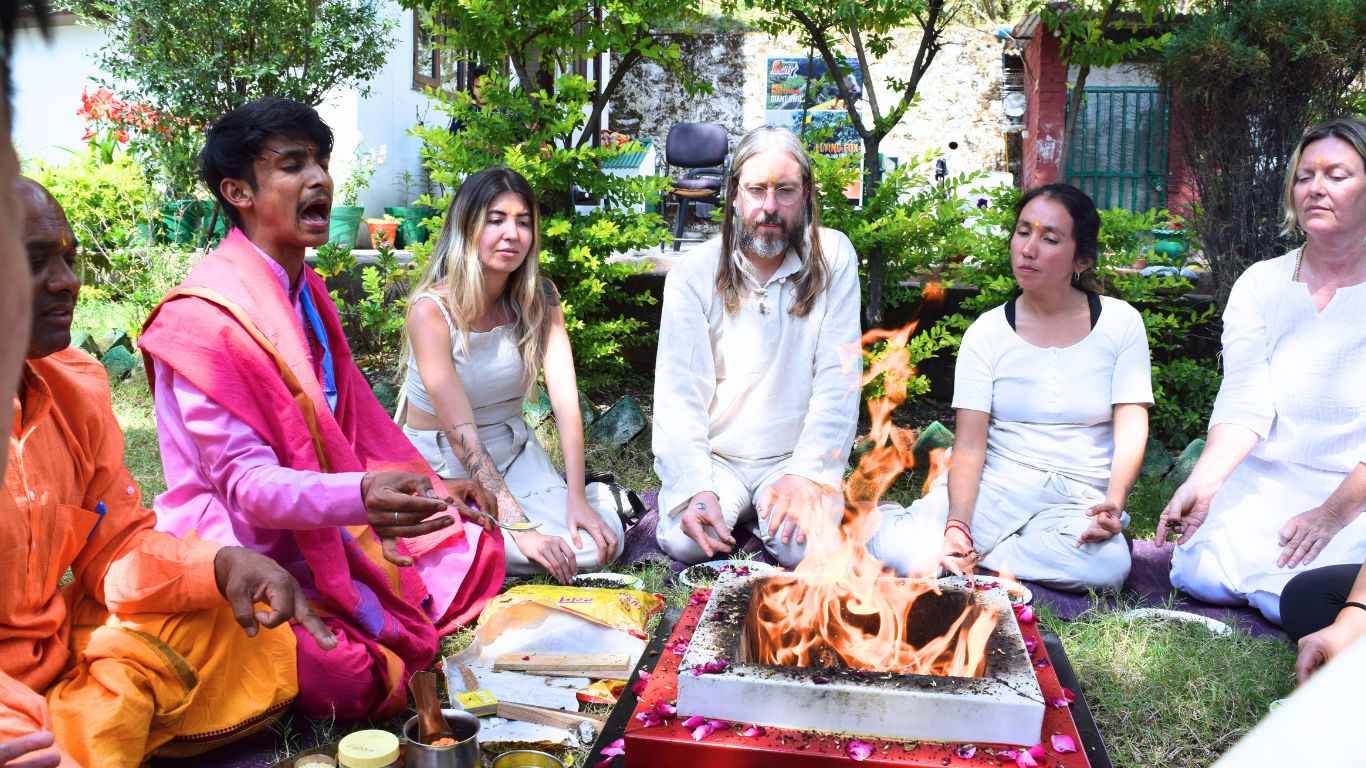The Pandit who was present to conduct the ceremony began by preparing a mini altar on a flat wooden raised surface. He used wheat flour (atta) to create the symbols of Om, Swastika, Shri, a house to represent Navgraha ( 9 planets), a Lotus to represent Lord Ganesha and a Nakshatra house to represent Lakshmi Devi. He then poured some red sindhur powder in the center of the Lotus flower, in three houses of the Navgraha and other specific spaces. He also placed 3 nutmeg seeds in the three houses. He then prepared paan (betel) leaves bonded together with clove buds, these were placed on little paper plates along with two fruits and a sweet. These would be offered to the Gods as prasad (blessed food) and later consumed by us as blessed gifts.
Vedic Havans are not rituals. They are part of the science of the Vedas which existed before science existed. This science is our connection to the energy that exists in the Cosmic Universe. As in science, the results of a Havan are perfect and precise if performed correctly. The energy channelized during a Havan is experienced by each individual depending on their awareness and participation during the ceremony.
A full coconut was placed in a copper pot, decorated with paan (betel) leaves and flowers, and placed on top of the Shri symbol. Next to the little wooden slab, there was placed a paper bowl of rice with two nutmeg seeds wrapped in kautuka thread representing Lord Ganesh and Lakshmi Devi, curd, a small copper pot and spoon filled with water, two incense sticks, and a mud bowl filled with ghee to light the Diya
The ceremony starts with a prayer by the Pandit who is seated in front of the mini offering space and the rest of us seated around him. He gave each of us grains of rice which he asked us to throw at intervals into the air on his signal as he chanted. He then put Sindhur tikkas on each of our foreheads. As he chanted prayers for each of the symbols drawn he gave a few petals of flowers to each of us, and when the prayers for that symbol were over, we would put all the petals over that symbol. This was carried out until blessings were sought from each of the Gods. At two different moments during the ceremony, he also placed a few drops of water on the ground and asked each of us to dip our finger into the water and apply it to our eyes.
He tied the Kautuka or Mauli Thread on each of our wrists and one of us tied it on his wrist to complete the circle. During the ceremony, a band of Mauli thread was also placed on Lord Ganesha’s symbol and the Coconut each.
The Kautuka or Mauli thread is a red-yellow thread that is also sometimes called Raksasutra / Moui / Pratisara / Kaapu/ Kariyu / Charandu depending on which part of the country you are in. It is traditionally believed to be protective and appears in the Vedic texts Atharva Veda Samhita section. It is also said to turn away misfortune, remove evil eye, or any sort of harmful influences. It is said to depict Lord Vishnu (the God of Balance) for men and Lakshmi (the God of Abundance) for women. Married women generally wear it on the left hand while unmarried women on the right hand. The significance of this is related to the story of Shiva and Parvati. Whenever the two are depicted, Parvati is always sitting to the left of Shiva.
After this ceremony, the Havan begins. Pieces of Mango wood are placed inside a Havan Kunds or a pedestal for the sacred fire. This container is always square in shape to represent the 4 dishas or directions, ie. North, South, East, and West. In the olden days, these Havan Kunds used to be built from the earth in the ground itself. Today, they are portable and made of metal. A camphor ball along with some ghee is added to help ignite the fire.


